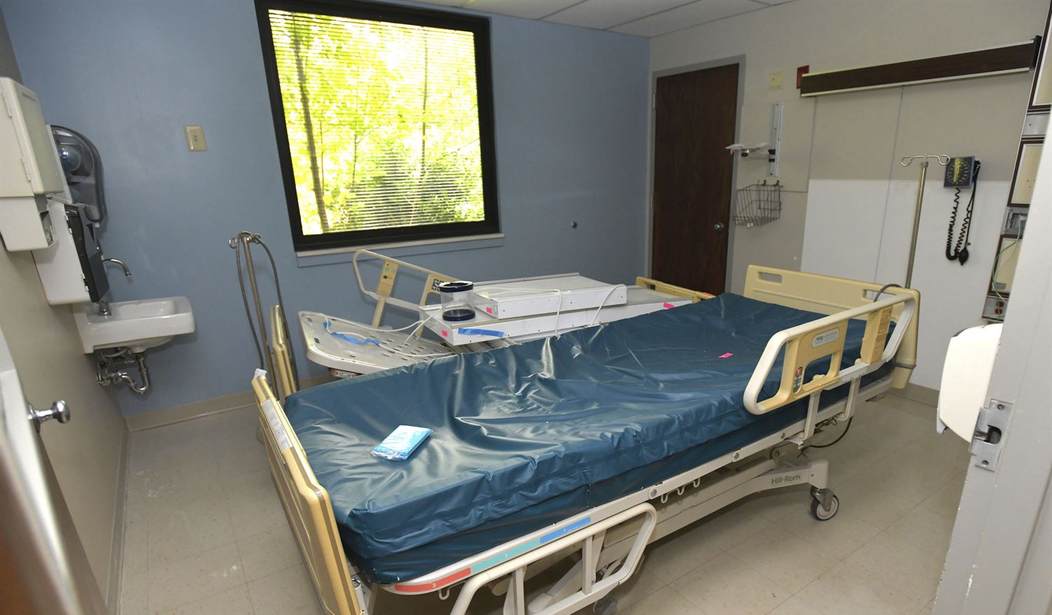If you missed it yesterday, a new report in The Atlantic -- authored by the same journalist who has done worthwhile and important work on the efficacy of masking children in schools -- has revealed that a significant percentage of much-discussed "COVID hospitalizations" don't live up to that billing. This harkens back to the debate over people dying of COVID, versus people who died with COVID. The former group were stricken by the deadly illness, which contributed heavily to their subsequent deaths. Members of the latter group met their demise for some other primary reason, and incidentally also happened to have COVID at the time. There's a reasonable case to be made that the 'of COVID' group should count as bona fide COVID deaths, whereas those in the 'with COVID' column should not. Now let's take that same principle, and expand it out to Coronavirus hospitalizations, another important metric:
A new study suggests that almost half of those hospitalized with COVID-19 have mild or asymptomatic cases.
— Nicole Saphier, MD (@NBSaphierMD) September 14, 2021
Being hospitalized *with* is very different than being hospitalized *from* CoV2. It’s ridiculous these two are still being reported together. https://t.co/McjvN9vHNS
Our data on this subject hasn't been great, to put it mildly, so COVID hospitalizations have acted as something of a black box. Some needed, contextualizing sunshine has now arrived:
Another worrying statistic is often cited to depict the dangers of this moment: The number of patients hospitalized with COVID-19 in the United States right now is as high as it has been since the beginning of February. It’s even worse in certain places: Some states, including Arkansas and Oregon, recently saw their COVID hospitalizations rise to higher levels than at any prior stage of the pandemic. But how much do those latter figures really tell us? From the start, COVID hospitalizations have served as a vital metric for tracking the risks posed by the disease. But a new, nationwide study of hospitalization records, released as a preprint today (and not yet formally peer reviewed), suggests that the meaning of this gauge can easily be misinterpreted—and that it has been shifting over time. If you want to make sense of the number of COVID hospitalizations at any given time, you need to know how sick each patient actually is.
Until now, that’s been almost impossible to suss out. The federal government requires hospitals to report every patient who tests positive for COVID, yet the overall tallies of COVID hospitalizations, made available on various state and federal dashboards and widely reported on by the media, do not differentiate based on severity of illness. Some patients need extensive medical intervention, such as getting intubated. Others require supplemental oxygen or administration of the steroid dexamethasone. But there are many COVID patients in the hospital with fairly mild symptoms, too, who have been admitted for further observation on account of their comorbidities, or because they reported feeling short of breath. Another portion of the patients in this tally are in the hospital for something unrelated to COVID, and discovered that they were infected only because they were tested upon admission.
Recommended
Writer David Zweig mentions a California study we covered months ago that determined pediatric hospitalizations were being dramatically over-reported under the existing system. It found that between 40 and 45 percent of these so-called "COVID hospitalizations" among children entailed kids who showed up at the hospital for various ailments or emergencies that had nothing to do with the virus. Because all incoming patients are required to undergo a COVID test, these children discovered they were positive for Coronavirus incidentally; i.e., the virus was not the cause of their arrival at the hospital. In other words, many of the (still very few) children hospitalized with COVID during this pandemic were not hospitalized for COVID. Is this phenomenon replicated among adults, too? Back to Zweig's summary of the new study:
The authors of the paper out this week took a different tack to answer a similar question, this time for adults. Instead of meticulously looking at why a few hundred patients were admitted to a pair of hospitals, they analyzed the electronic records for nearly 50,000 COVID hospital admissions at the more than 100 VA hospitals across the country...The study found that from March 2020 through early January 2021—before vaccination was widespread, and before the Delta variant had arrived—the proportion of patients with mild or asymptomatic disease was 36 percent. From mid-January through the end of June 2021, however, that number rose to 48 percent. In other words, the study suggests that roughly half of all the hospitalized patients showing up on COVID-data dashboards in 2021 may have been admitted for another reason entirely, or had only a mild presentation of disease. This increase was even bigger for vaccinated hospital patients, of whom 57 percent had mild or asymptomatic disease.
Nearly half of all "COVID hospitalizations" earlier this year were among people who were asymptomatic, or only mildly symptomatic, strongly suggesting that those hospitalizations were not primarily linked to COVID, if they were at all. And among vaccinated people, an outright majority of their "COVID hospitalizations" appear to have fallen into this less-than-concerning category. Zweig correctly highlights certain limitations to this research -- namely, that VA patients skew heavily male, and that the data gathering stopped just as America's Delta wave was building. Those are shortcomings, for sure, but perfect studies are rare, and this work at least takes a meaningful and wide-ranging stab at examining a very important question. His conclusion: "The study also demonstrates that hospitalization rates for COVID, as cited by journalists and policy makers, can be misleading, if not considered carefully. Clearly many patients right now are seriously ill. We also know that overcrowding of hospitals by COVID patients with even mild illness can have negative implications for patients in need of other care. At the same time, this study suggests that COVID hospitalization tallies can’t be taken as a simple measure of the prevalence of severe or even moderate disease, because they might inflate the true numbers by a factor of two."
ICU's crowded with unvaccinated COVID patients are not a myth, even if the problem isn't as widespread as some headlines might suggest. A great many people are, and have been, hospitalized with extremely serious COVID symptoms (again, these are overwhelmingly unvaccinated people). Far too many have not survived, tragically. That can all be entirely true, even as we also reconsider how useful broad "COVID hospitalization" statistics are in assessing how serious the crisis is at any given time, and formulating the public policy choices that flow from that assessment. I'll leave you with yet more data pointing to the awful Delta wave receding in warm-weather, hard-hit states (we may well see seasonal spikes in other regions in the fall and winter), and a sleazy Democratic spokesman's gross new talking point mocking Florida's dead:
Some ER visit charts for southern states.
— Phil Kerpen (@kerpen) September 14, 2021
You can see all states that report to CDC in this format here --> https://t.co/btTnw69DIv
Copy the sheet to enable the state drop-down menu. pic.twitter.com/wnUPmu6CEr
@jimmykimmel mocks Floridians who’ve died of Covid: “Of the 54,000 Americans who died from Covid since the start of the summer, almost one of five — one in five of them died in Florida, which my God, all those orphaned ferrets, it’s a shame.” pic.twitter.com/U9jMgCVyKt
— Tom Elliott (@tomselliott) September 14, 2021
Notice how Kimmel cherry-picks a time frame to make Florida look as bad as possible, neglecting to mention that the Sunshine State is above average on vaccination rates. And although Florida has moved in the wrong direction on COVID death rate per state, it remains outside the top ten, which are split exactly evenly between blue and red states. Update: I discussed the hospitalizations study on Special Report last evening:
COVID CONFUSION: @guypbenson On The Mixed Messages From WH On Covid Booster Shots pic.twitter.com/COutjIUVL5
— The Guy Benson Show (@GuyBensonShow) September 14, 2021

























Join the conversation as a VIP Member